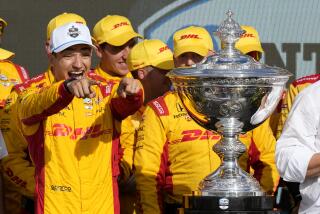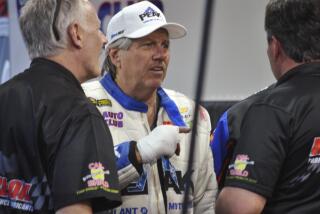Earnhardt Was in Wrong Place When Race Took Tragic Turn
ROCKINGHAM, N.C. â NASCAR drivers are gathering today at North Carolina Speedway for Sundayâs Dura-Lube 400, second race in the Winston Cup season, but, in their hearts and minds, most have still not moved on from the final lap of last Sundayâs Daytona 500. About the only talk here is of the shocking accident that took the life of an American sporting legend.
The revelation Friday by NASCAR President Mike Helton that Dale Earnhardtâs death might be attributed to a broken seat belt is the latest development as officials continue their probe into the accident that has captured public attention like no other motor racing tragedy.
It started as an innocent little bump, one of probably hundreds during intense side-by-side racing at speeds approaching 200 mph.
The incidents before and after that little bump--only a half mile from the finish line of the yearâs most important stock car race--are detailed here.
*
With 10 laps remaining, 10 drivers were thinking of victory, running five-deep in two rows with no one giving an inch as they stormed around the 2.5-mile tri-oval with its 31-degree banking in the corners.
Michael Waltrip was on the point, but few among the 200,000 spectators at the race expected him to stay there after the first 184 laps had produced 49 lead changes among 14 drivers. First place had not been the place to be.
Five laps to go and Waltrip still led, leading to supposition that Dale Earnhardt Jr., the elder Earnhardt, Rusty Wallace, Ken Schrader, Sterling Marlin, Ricky Rudd and Bill Elliott might be setting him up for a late lap pass.
Little changed before the lead pack took the white flag signaling the beginning of the final lap. Waltrip still led with the Earnhardts right behind. Nothing changed through the first two turns as everyone but Waltrip seemed to be jockeying for position. Waltrip was trying to take his Chevrolet Monte Carlo as wide as possible, his rearview mirror telling him where to go to block anyone attempting to pass.
Wallace, hoping for his first Daytona 500 win, was in the best position to see what happened on the fateful east end of the track.
âEverybody was giving it all they had,â he said. âI went down into turn three and I got a run on everybody and got in there between Schrader and Earnhardt and looked in my mirror and saw Bill Elliott right behind me and then Ricky Rudd.
âI donât know what was going on behind us when all that happened, but I was able to pass Schrader and Earnhardt going into three. I saw Dale get sideways into three and I jumped on the throttle and got right between âem, so I cleared Dale and I cleared Schrader and then all hell broke loose.â
Rudd, in one of Robert Yatesâ Fords, said all he saw was âparts, pieces and clean air and thatâs where I went. I didnât wait around to see what happened.â
Earnhardt was in the most vulnerable spot, in the middle, the place most drivers dread because they have no option of moving higher or lower on the track.
Nothing that had happened indicated anything other than that âthe Intimidator,â as Earnhardt was known, was geared to win his second 500. Earlier in the race, he had made a frightening--yet spectacular--pass, going far down on the tri-oval apron to sweep past Ron Hornaday. There is no evidence that, as some have speculated, he was merely on the final lap trying to provide a buffer between Waltrip and Earnhardt Jr., both of whom were driving Earnhardt-owned cars, and the rest of the field.
Halfway through that final lap, Marlin was on the low side, hugging the edge of the asphalt in his Dodge Intrepid. Only three days earlier, in a similar position, he had passed Earnhardt on the second turn of the final lap to win a Twin 125 heat race.
Immediately after the 500--not knowing Earnhardt had crashed, or that his No. 40 Dodge Intrepid had sent Earnhardt into the wall when their fenders touched--Marlin said:
âI couldnât get any [drafting] help. Ken Schrader tried to help, but with Michael Waltrip blocking, Earnhardt blocking and Earnhardt Jr. blocking . . . thatâs what youâre supposed to do . . . and there wasnât much I could do.â
As more often happens than not, when one car spins out of control, the other car may continue on. Marlin was slowed, but finished seventh.
Later, he explained in more detail:
âI got under Dale on the back straightaway. I thought Schrader was going with me, but when I looked in the mirror I saw that he was going to the outside. I knew we were going to be three-deep getting into the corner.
âI went to the bottom. Rusty came up and really closed in fast. He really came up on Dale and I donât know if that got him loose or whatever. But I was as low as I could go. We touched and kind of got away from each other. He straightened up and I thought, âOK, weâre OK now.â
âThen, all of a sudden, Earnhardt came back down. Thatâs what can happen when youâre in the middle; it takes the wind off of you. We touched again and it knocked my car back across the apron. The last I saw was Daleâs car going up the banking.â
When the black No. 3 slid toward the wall, Wallace cleared him by scant inches, but Schrader had no place to go. Their two cars slammed into the wall, Earnhardtâs hitting almost head on.
âI donât know for sure what happened,â said Schrader, who climbed out the window of his car and ran over to Earnhardt, then motioned for rescue workers.
âWe were all spread out going down the back straightaway. I knew that was going to happen. They spread out, so I just hung with the guys on the outside. I guess someone got into Dale because Dale got into me and then we went up. We hit pretty hard and Dale hit harder. I went over to [Daleâs] car and then [the rescue crew] got there real quick, so I got the hell out of the way.â
A half-mile down the track, Michael Waltrip was still holding off Dale Jr., to win the Daytona 500, his first Winston Cup win in 463 tries. Neither knew of the Earnhardt-Schrader crash until Schrader walked into Victory Lane and told them.
âHowâs my daddy?â Earnhardt Jr. asked a television commentator he knows.
Receiving no answer, he immediately ran toward his fatherâs car.
Paramedics, stationed near the fourth turn, were the first to reach Earnhardtâs car, which had slid back down the track and onto the grass.
One paramedic climbed through the passenger window and applied oxygen by a mask.
Dr. Tim Alson, a trauma surgeon, delivered CPR through the driverâs window.
Another paramedic struggled through the window to maintain the C-spine, holding Earnhardtâs head.
One of the paramedics swarming over him was the first to notice that one of his seat belts was broken.
Firefighters came next, climbing onto the roof with saws and the Jaws of Life to get the roof off. This is not an uncommon circumstance in Winston Cup racing when a driver--seriously injured or unconscious--cannot be removed through the window. There are no doors on the cars, forcing drivers to climb in and out through the windows.
Dr. Steve Bohannon, the trackâs emergency medical officer, had been in an ambulance on the back straightaway when the accident occurred. He arrived shortly after the first paramedics. When the roof was removed, he and Alson immediately called it a âload and goâ situation.
Earnhardt was taken from the car and transported to Halifax Hospital, a Level Two trauma center not more than two minutes away. CPR was administered during the short trip.
As soon as Earnhardt was lifted from the car, it was covered with a blue tarp to prevent ghoulish curiosity seekers from staring at the wreck.
The hospital trauma team had been alerted and was waiting for him. It was 4:54 p.m. when he arrived.
Dr. William Kuhn, a trauma neurosurgeon; Dr. Jose Dimayuga, a trauma surgeon; an anesthesiologist; and several emergency room doctors were on the team that administered full trauma resuscitation for about 20 minutes, at which time Earnhardt was placed on a ventilator. He was given cardiac drugs to try to get the heart started again. Chest tubes were put in, multiple IV lines were given, and various diagnostic tests done.
At no time did he have a pulse or show any signs of life, from the time the first paramedics arrived, Bohannon said.
He was declared dead by all the physicians in attendance at 5:16 p.m.. His wife, Teresa, and Dale Jr., were at his bedside.
An autopsy showed that Earnhardt died from a severe fracture to the base of his skull that damaged the soft tissue in his brain.
âMy understanding is that death was instant,â said Dave Byron, a Volusia County coronerâs office spokesman. âHe died at the scene.â
The car was taken by NASCAR and remains in its custody.
Earnhardtâs racing suit, black gloves, black socks, underwear and racing boots were given to his wife.
The Daytona Beach police report was succinct. It read:
âOn 2-18-1 a crash occurred at the Daytona International Speedway on Lap 199. V-1 [Victim-Earnhardt] was the driver of the race car. V-1 was transported to Halifax Medical Center and arrived at 16:54 hours. V-1 was pronounced dead at 17:16 hours by emergency room doctors.â
Gary Nelson, Winston Cup series director, said the quest for more information has not ended.
âWe will continue to make sure we cover every base before we make any more statements as to what really happened in that car,â he said. âWhat we really want is to deal in facts. We are still searching for them.â
As wrecks go, it didnât appear to be anywhere near as serious as it turned out, not nearly as dangerous appearing as one bumping incident earlier in the race.
When Robby Gordon ran into the back of Ward Burtonâs Dodge, it triggered a 21-car accident scene that saw Tony Stewartâs car flying through the air to land atop teammate Bobby Labonteâs car. Stewart was hospitalized briefly, the only driver injured.
âHe hit me when my wheels were turning,â Burton said. âWhen that happens, thereâs nothing you can do.â
It will happen again Sunday here at North Carolina Speedway. Bumping is part of the game of stock car racing. Unfortunately, so is tragedy.
*
* EQUIPMENT FAILURE
Dale Earnhardt might have survived his Daytona crash if his lap belt had not broken, a NASCAR doctor said. A1
More to Read
Go beyond the scoreboard
Get the latest on L.A.'s teams in the daily Sports Report newsletter.
You may occasionally receive promotional content from the Los Angeles Times.










